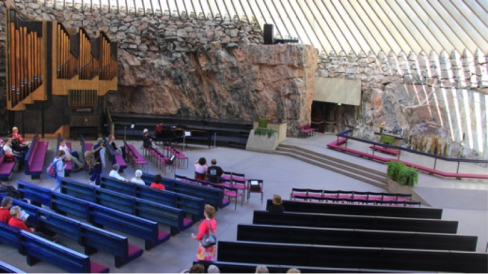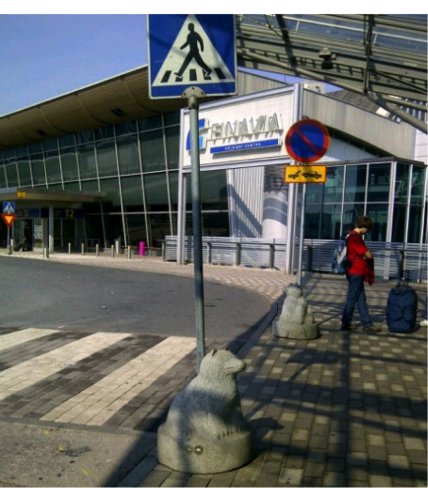With design as the conference theme there were always going to be opportunities for the European Group for Organizational Studies (EGOS) crowd to see whether they could live up to the Deputy Mayor of Helsinki’s introductory description of a city designed to be fun and functional, right down to the concrete bears holding the pedestrian crossing signs and the Temppeliaukion Kirkko, the Rock Church. This is design organised to be just necessary and sufficient.
The plenary sessions featured lots of nods to art, aesthetics, the need to be a bit more Steve Jobs and a bit less Bill Gates, to be functional and fun, pure and dangerous. Gibson Burrell’s opening keynote offered a ‘design cube’ with planes, voids and points within which all styles of organising exist. Burrell drew a line connecting Gaudi’s apartment blocks to the National Trust, then one connecting Wittgenstein’s homage to autistic architectural nostalgia in its longing for the perfect doorknob (Jobs too had such a neurosis for domestic perfection that his home for many years had all the plain clarity of next to nothing in it) to other things I’ve forgotten now even though the pictures of Blackwater stay with me, and then another 6 lines besides. Renate Meyer’s preoccupation was with the politics and aesthetics of order that make everything we do so normal. But this was EGOS, the home of Organizational Studies, so debate was never going to stray too far from questions of institutional, organisational design and whether all those Powerpoint operas moving resolutely from problem, to methodology, to data and variously provisional findings, are getting any closer to what really matters. Why – after all those careful research designs and all those tentative conclusions – Royston Greenwood asked, do we not understand the differences between institutions any better than in the 1960s? More perplexing, and maybe more to the point, Walter W. Powell asked whether the social sciences of organisation have learned anything yet about how to build better institutions on purpose.
This isn’t getting any less important as the academic feathers Aditya Chakrabortty ruffled in The Guardian stay that way, and as the coherent institutional response he was after remains in the ‘send us an email and we’ll send you a reading list’ category. As disarming as it was to hear Gibson Burrell’s flawless performance of the hapless academic driven to distinction by a thousand or more minor grievances, it’s not exactly clear that what the world needs now is another typology, this time in 3 dimensions, of organisational differences. As the reliably off-centre David Saunders always responds to what we jostle to establish as the Next Grand Theoretical Move (and yes some even mark them in uppercase, just in case) are there really not enough of them to go round yet?
An academy driven by superabundantproliferatingconcepts might keep us all busier trying to show how well we are keeping up than we are trying to figure out what happened, when? where? and how? But it also guarantees that the main conversations we’ll keep having are with smaller and smaller groups of people, who sound and look more and more like us. The ability to share accounts with people who see things from a different angle and describe them in different language is the casualty. When the crisis moment Chakrabortty laments came, when the economists, financiers, bankers politicians and journalists were cowed enough to listen, we were unequipped for the conversation and for that we are responsible – even if we are clearly not for the mess that was made.
Not that it’s easy. If Powell’s example is right, that even in our own backyard, the truest thing we can say about those rare things, the academic leaders who direct faculties, ‘without affection or enthusiasm’ (du Gay, 2008) but, soberly and competently -is that they act like small-town Mayors in charge of a population of three year olds, distributing treats and soothing wounds– then we still know nothing about how to manage when there really are not enough treats to go round.
One thing at least is clear –all those concepts might be a comforting sign that we have something to say but they have a tendency to get in the road when you’re trying to communicate. When our Charisma sponsored EGOS Industry-Academy Forum kicked off it was not entirely clear what sort of conversation we could have about market spaces, their successes, their failures, and how to design the kind of spaces people might actually fit into. From the start though, Harvey Molotch’s, now almost unique, determination to find colloquial ways of explaining complicated problems –offered reassurance that social science has actually got something meaningful, practical and important to bring to the policy process.
Acting like an unpaid and unheeded consultant to the commissioners of those public spaces – the airports, subways and tall buildings – that we all want to feel safe in, Molotch makes a compelling case that security is not so much a matter of taking extreme measures as it is one of adjusting spaces to what we know about human resilience. That makes ventilation, natural lighting, signage and stairs the priority over the grandiose statements of buildings like the One World Trade Center in New York, or The Shard in London, with their discordant machismo balancing of security and provocation. These buildings are all about organising the view. Intizam- al-manzar, as Timothy Mitchell (1989) explains, was how this peculiarly European preoccupation with organising what is seen was described by a nineteenth century Egyptian author. The world cast as exhibition is what these buildings do well, with their distanciations of time and space that turn the view into Google Earth and people on the street into featureless shade.
What goes wrong in these spaces is all in the accommodation. In all sorts of ways, the spaces and goods designed for public consumption; the buildings, parks, toilets, affordable homes, buses, tubes, roads and bicycles, just don’t always manage to accommodate people. In their baggy, heavy, encumbered form, real people don’t quite make it into architect’s models just as they don’t quite fit into systems of public provision, least of all the ‘marketised’ hybrid of public gone private (or even worse, public turned private turned public again). Far from being ‘groovy like the market’ , such schemes seem determined to combine the worst of both worlds – a disregard of lived experience with the worst kind of surplus extraction where, in Andrew Haldane’s (2012) formula, riches get privatised but rags get socialised.
Building the type of market spaces that fit people comfortably, that not only accommodate their needs but might enrich their experience, is a core principle of Constantine Roussos’ lobbying for the internet domain “.music”. The sinister sounding Internet Corporation for Assigned Names and Numbers (ICANN) is in the process of awarding top-level domain names (gTLDs for the technically inclined) in a massive expansion of the internet’s domain name system.
Predictably, global corporations are ahead in the scramble for names with bids for “.apple”, “.amazon”, “.gap” coming largely uncontested from the obvious applicants, but where domains intended for communities are at stake it gets more complicated. There are 8 bids for the gTLD, “.music”, of which Roussos’ is one of only two that can claim to be attempting to secure .music for a music community. Other bids from applicants like Google and Amazon to register the .music domain, Roussos explained, just don’t see the domain business as a community issue. Roussos has lots of convincing reasons why it is and lots of equally convincing reasons why community control of the domain would be a better fit for musicians, associations and their publics.
One of the most surprising- but in a good way – aspects of Roussos’ talk is the emphasis he placed on an academic collaboration as a factor in making his bid a front-runner against some colossal opponents. Having had help from Charisma members Joeri Mol and Dean Pierides, in interpreting and meeting ICANN’s complex list of criteria – maybe negotiating all those academic funding systems has more value than we thought – he was gracious in acknowledging these debts. This sense of the potential of collaboration to reach some unexpected ends was also a feature of Elie Ayache’s provocative recasting of derivatives in his conversation with University of Melbourne philosopher Jon Roffe. Ayache, himself a derivatives trader turned philosopher, upends all the handwringing about financial markets, all the searching for causes and effects, by suggesting that market events are non-reproducible outside of themselves. Derivatives are not derivative of anything, they are merely contingent claims, whose medium is the market.
This pitch against the very idea of prediction is discomforting but plausible enough in the current context. The performative solution generally favoured in the social studies of finance, has human beings ‘framed, formatted and equipped’ in Michel Callon’s (1998) words, to calculate roughly in line with economists’ models. Always controversial as a sociological explanation, the debate has got more feverish – or more jaded, depending on your point of view – the longer the current spate of financial crises endure. If the ‘quants’, the technicians and mathematicians, the analysts, managers and traders, that make up high finance failed to calculate according to the models, and if the regulators failed to notice and/or effectively intervene and if the academics specialising in finance or its social study also failed to remark on just how precariously sheets were being balanced – well, then the conceit that human beings calculate, whether purely, rationally, situatedly or materially, starts to look like exactly that –a conceit.
Donald Mackenzie’s (2009, 2011) modest explanation that almost everyone in high finance saw parts of the problem in the Russian doll structure of ABS-CDOs (Asset Backed Securities combined with Collateralised Debt Obligations) but almost no one saw all of it is probably true – it just doesn’t by itself much advance the understanding of what market calculation is, if it’s not what economists and sympathetic sociologists have claimed it is. Mackenzie concludes that the knowledge failures showcased by the crisis are an argument for broader disciplinary analyses of financial markets and more economic sociology to explain how things went so wrong. But as he nods toward the bundle of new sociological statements made about market calculation – viz. judgement, valuation, value, quality and qualification – he avoids making any final comment about whether a new, more useful economic sociology needs to tidy up – or forfend, even reduce – its technical, conceptual vocabulary first.
For Mackenzie, the answers to questions like did finance folk calculate, if so, how, and were these calculations amoral, always has to be empirical. As necessary as evidence is for understanding broadly what happened in financial markets it’s unlikely to be enough to restore confidence in the contribution economic sociology can make to understanding market calculation and regulating its boundaries. As the Chakrabortty spat demonstrates, the social and political sciences have yet to develop a coherent public voice in the post crisis policy debate. Whatever the multiple factors that have inhibited the development of an effective public economic sociology of the type summoned by Burawoy (2005) and Swedberg (2006); the proliferation of internal approaches and vocabularies has hardly helped and may have even been at the expense of a more coherent, external facing vocabulary.
One of the consequences of the crisis is that specialist mathematical and econometric knowledge claims, have come in for questioning, about their accuracy, validity and reliability, of a type usually reserved for the softer human sciences. Amidst the confusion that has taken place since 2007 few heroes have emerged and those who expected the social and political sciences to at least escape unblemished have been surprised to discover that they too, have been found disappointing. However premature, partial or ill-informed some of this post-mortemising has been it’s difficult to argue that the concept of calculative action, can remain entirely intact. The crisis forces an acknowledgement that the distinction between incalculable Knightian uncertainty and calculable, and therefore price-able, risk is less secure than it’s been modelled. This is not just a problem for high finance; the same is true of low or domestic finance and household consumption generally. The difference is that domestic consumers don’t usually insist they’ve calculated well, rather they hope they’ve not done it too badly.
This gap between consumer experiences of markets and how they are modelled academically was one of the motivating factors for establishing Charisma. As a launch event Designing Market Spaces simply reinforced the need to extend the conversation if we want any hope of closing the gap.
Sources and further information
Aditya Chakrabortty (2012) on the social and political sciences:
http://www.guardian.co.uk/commentisfree/2012/apr/16/economics-has-failed-us-alternative-voices
http://www.guardian.co.uk/commentisfree/2012/may/07/academics-cant-answer-criticism-analysis
on The Shard:
http://www.guardian.co.uk/commentisfree/2012/jun/25/shard-metaphor-for-modern-london
Andrew Haldane (2012) ‘The Doom Loop’ London Review of Books, Vol. 34 No. 4 ·23 February .
David Saunders (2005) ‘The Moment of Theory in Critical Legal Studies’; see The History of Theory http://www.ched.uq.edu.au/index.html?page=40667
Donald Mackenzie (2011) The Credit Crisis as a Problem in the Sociology of Knowledge 1. American Journal of Sociology, 116(6), pp.1778–1841.
Donald Mackenzie (2009) Behind all the toxic acronyms lies a basic cultural issue. Financial Times, November 26
Elie Ayache (2010) The Blank Swan: The End of Probability, Wiley
ICANN: http://www.icann.org/en/news/announcements/announcement-13jun12-en.htm
Joeri Mol, Jon Roffe and Dean Pierides (2011) The Market Multiple project see http://benews.unimelb.edu.au/2011/mckenzie-postdoctoral-fellowship-success/
Michael Burawoy (2007) Public sociology vs. the market Socio-Economic Review, 5(2), pp.356–367
Michel Callon (1989) The Laws of the Markets, Blackwell.
Paul Du Gay, (2008) ‘Without Affection or Enthusiasm’: Problems of Involvement and Attachment in ‘Responsive’ Public Management. Organization, 15(3), pp.335–353
Richard Swedberg (2007) Public sociology and economic sociology: introductory remarks, Socio-Economic Review, 5(2), pp.319–367
Timothy Mitchell (1989) The World as Exhibition, Comparative Studies in Society and History, pp.217–236.
DESIGNING MARKET SPACES: HOW IT CAN GO WRONG AND HOW TO PUT IT RIGHT? An Industry/Academy Forum; EGOS Colloquium
Saturday, July 7, 2012; 14:00–17:00 Hanken School of Economics, Helsinki
Organisers: Liz McFall, Joeri Mol , Jon Roffe and Dean Pierides
This industry-academia dialogue followed debates in EGOS sub-theme “Markets in the Making: Observing, Measuring and Performing Economic Exchange” in a review of the challenge of designing and building spaces for market, public and professional encounters. The session brought academics into conversation with leading figures from the finance and internet industries to explore the issue of market design.
Urban and design sociologist Harvey Molotch (New York University, USA) used themes from his forthcoming book “Against Security: How We Go Wrong at Airports, Subways and Other Sites of Ambiguous Danger” to start the debate. He was followed by industry participants Elie Ayache, author of “The Blank Swan: The End of Probability” and co-founder and CEO of ITO 33 and Constantine Roussos, a leading campaigner for the internet domain name ‘.music’.
The session was sponsored by the Charisma network, the Centre for Research on Socio-cultural Change (CRESC), the Journal of Cultural Economy (Routledge, Taylor & Francis) and the Department of Management and Marketing, University of Melbourne.


